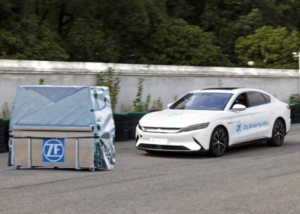ZF has debuted a brand-new, all electro-mechanical braking system. Without the need of brake fluid or a hydraulic system, an electric motor provides the braking force at each wheel. For the worldwide market, the brake system was created at ZF’s development centers in Germany, the United States, and China.
 Holger Klein, CEO of ZF Group said, “Our purely electrically controlled braking system is a significant addition to our portfolio of networked chassis systems. With such by-wire systems, we are opening the door to a new era of vehicle control. This is especially true in software-defined and electrically driven vehicles where this type of brake system has even more advantages and open up new freedom in design and development.”
Holger Klein, CEO of ZF Group said, “Our purely electrically controlled braking system is a significant addition to our portfolio of networked chassis systems. With such by-wire systems, we are opening the door to a new era of vehicle control. This is especially true in software-defined and electrically driven vehicles where this type of brake system has even more advantages and open up new freedom in design and development.”
Safe, reliable and sustainable
Compared with conventional braking systems, the new brake-by-wire system, like Integrated Brake Control (IBC), enables shorter braking distances, better recovery of braking energy, and lower maintenance costs.
During automatic emergency braking, the braking distance at a speed of 100 km/h can be up to nine meters shorter than with conventional braking systems. In addition, electric cars can achieve up to 17 percent more range via even better recuperation of braking energy.
With dry brake-by-wire systems in particular, the residual drag torques that occur with conventional braking systems due to minimal contact between the brake pads and the brake discs can be reduced to almost zero. This results in even fewer particulate emissions due to brake abrasion. This lower resistance during driving also saves energy and can increase range in an EV.
Dispensing with a hydraulic system means significantly lower assembly and logistics costs even during vehicle production, as the system consists of fewer parts. And during the vehicle’s service life, the user benefits because brake fluids no longer need to be changed, reducing the amount of servicing required in the workshop.
Even though there is no longer a mechanical connection between the brake pedal and the brake actuators, the braking feel is the same as that of a hydraulic brake. The safety of the data transmission and processing as well as the energy supply to the electric motors is ensured by the duplication of all connections and systems, as is also common in by-wire systems in aviation.
Purely electric, purely hydraulic or combined
Vehicle manufacturers can put together their optimum braking system from the classic purely hydraulic to the new purely electric braking system depending on their requirements. Hybrid forms with, for example, a hydraulic system at the front and a purely electric system on the rear axle are also possible. In addition, ZF offers all components of a braking system from a single source, from wheel brakes to parking brakes, and hardware to software.
By-Wire in combination: brake, steering and damping
ZF has one of the most comprehensive portfolios of purely electronically controlled steering, brakes or damping systems for software-defined vehicles. “Networked chassis systems for longitudinal, lateral, and vertical dynamics can improve driving dynamics, and ZF is uniquely positioned in the market with its range of actuators and functions for combining all three dimensions of vehicle dynamics as well,” said Klein.
